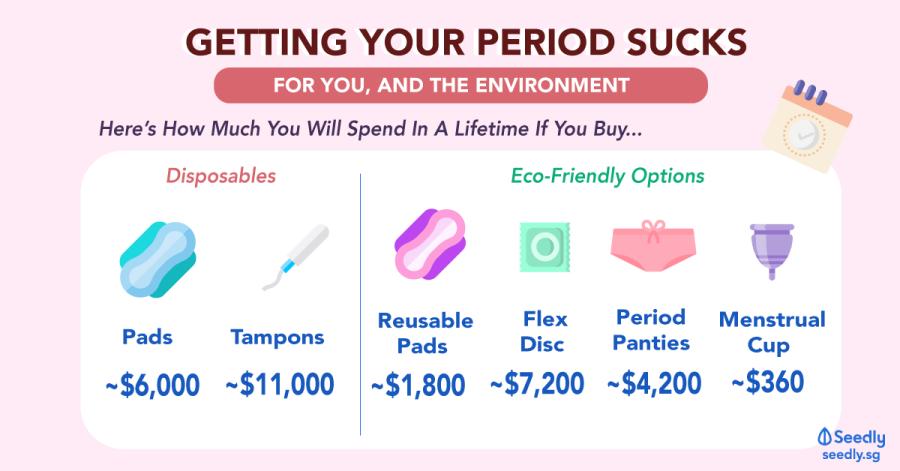Should feminine products be free at schools?
Opinions vary on this controversial topic
April 7, 2023
Woman to woman, feminine products should be free in all public restrooms, but they are actually around 75 cents.
Why? You never know what some people go through and not everyone uses coins anymore. Most people mainly pay for things using things online or just their card.
Yes, as an adult I can understand having them pay in stores and whatnot, but what about us teens most of us might not have a job. To loop in with the parents, schools have free lunch programs for the families that can’t pay for it.
So even in stores feminine products are overpriced.
According to Now.Org, “The average woman spends about $20 on feminine hygiene products per cycle, adding up to about $18,000 over her lifetime.”
According to Weforum.org, “In the United States, one government study analyzed 800 gender-specific products from nearly 100 brands. The report found that, on average, personal care products targeted to women were 13% more expensive than similar men’s products. Accessories and adult clothing were 7% and 8% more expensive, respectively. The study concluded that “women are paying thousands of dollars more over the course of their lives to purchase similar products as men.” Another US study found that dry cleaning prices for women’s dress shirts were upwards of 90% more expensive than for men’s shirts.”
To support people who need the help, in Mr.Hayes room X109 there are plenty of feminine products available for free (these were donated by students). Please utilize it as you will need.
Here are some others women intake on that they go through monthly:
Amber Stark, 2012 Ben Davis graduate states, “I think it’s dumb they’re charging for stuff like that in general because we didn’t ask to have a menstrual cycle and we shouldn’t have to pay for a product for something that comes natural to us as women. Yes they should be free in restrooms and in stores. It’s severely overtaxed. Google pink tax, pink tax is charging females a lot more for all female products in stores, including clothing, hair and body products and hygiene products. Shampoo conditioner and body should cost the exact same as mens products.”
Taylor Stark, 2017 Ben Davis graduate states, “I agree with Amber. it’s completely stupid, it’s over priced, and we should be getting them for free. We didn’t ask to have periods.”
Brittany Stark, 2011 Ben Davis graduate states, “I think they should be free because a woman doesn’t choose to have a period and either the price of food and gas and home life we shouldn’t have to pay for things that we have no choice over.”
Misty Hughes, Ben Davis parent, “Well I think that they shouldn’t cost more than .25¢ in a public restroom and I believe they should be free in schools and private restrooms.”
Emily Diem-Hughes, Ben Davis 2008 graduate and parent, “I don’t think they need to be free… At most a tampon is like 50 cents.. as a female you should always be somewhat prepared.”
Jenifer Laughlin, Ben Davis parent, “I think there should be an unlimited supply of feminine products in women’s public restrooms. There should also be an unlimited supply of feminine products for women/ girls in school restrooms. For my opinion on the cost, I feel like it should be at no cost to women, because some women don’t have jobs or don’t have money on them and that is a serious thing that needs to be addressed when it happens. I feel like women should get free access to them at least in the restrooms.
“As for charging you for them at the cash register that depends on the brand, it’s out of the cashier’s control, I do feel like they should be cheaper though.”
Grace Holler, Ben Davis student, “In schools and restaurants feminine products should be supplied for free. Most women barely have the money to buy certain items as it is and women don’t ask to have a menstrual cycle. To a certain extent, places should have feminine products supplied, especially for emergencies. Most women also don’t carry money on them and sometimes your menstrual cycle comes out of the blue, so what are women supposed to do in that situation?
“Women should pay for feminine products when purchasing them at the store. However, I do believe that women should not be paying as much as they are right now. The places that make feminine products do need a profit for making the products and they need funds to make more products available. I would suggest something along the lines of a government debit card, similar to food stamps, that allows women who are struggling to get help purchasing these items. While those who aren’t struggling as much, the products should still be cheaper because it’s a necessity for women to have.”
Kimberly Bustos Hernandez, Ben Davis student, “Feminine products should be free. These things are a necessity not a want. Especially when cycles can be unpredictable and one can be unprepared.I am not sure about a set number because of factors like qualities and amount but in general it shouldn’t be expensive from the $3-5 range. Especially since it’s a necessity and not a want.”
Jeanna Bauer, Ben Davis teacher “ I don’t think having them free in public places would be a good idea because of several reasons — I don’t think people are honest and someone would take more than one, someone has to be hired to refill the products and that would have to be many paying jobs, and who decides what is public?
“Are store restrooms public or do they belong to the store? What about mall restrooms? Gas stations? The list goes on and on. I don’t know how much it costs to make feminine articles, but given the fact that so many are sold, the companies that make them certainly don’t have to worry about women not needing them. There are alternatives to feminine hygiene products that other countries are already investing in and I believe that we need to educate our young girls on these alternatives as they are less expensive and in most cases work better. No matter what, I don’t think they should be taxable. Prices of items aren’t just the cost of the item; it’s the cost to make, ship, store, and sell the item. All of these require different people to be paid, so if the companies only charged what it cost them to make the product, the other people still need to be paid. The only way we could get around that would be if the government subsidized the price. That would involve passing some sort of law, or whatever it is they do when they give money for things.”
Rebecca Hundley, Ben Davis teacher, “Period products should be free everywhere. PERIOD end of story. Since this is a biological monthly occurrence that cannot be stopped/prevented naturally, then it should be free. There should be no charge. We need to figure out a system (Scotland does this already) in which we let people who have periods check out with a certain card/waiver every month for period products. There are things like menstrual cups that can be a waste free, cost effective, way to also get rid of a monthly payment for period products too.”
Lori Welter, Ben Davis teacher, “Ideally, menstruation products would be free in public restrooms but I’m not sure that all places would be able to do that. The machines probably need an update too since they take quarters and not many people are carrying loose change anymore. Schools should definitely have free products, but having them in the restrooms has caused some problems with vandalism. My preference would be that products are available in the clinic restroom. If someone needs more than just one, maybe we could have kits/boxes of supplies in the care closet or include them in Giant Marketplace pantry boxes. Again, who is going to pay for the products? I’m not sure about how much they should cost, but I would like them to be part of SNAP benefits (I’m not sure if they are or not). Low cost items at Planned Parenthood or other clinics would be a good option for some people (if they could get to the clinics).”
Viktoria Tomanov, Ben Davis teacher, “In a perfect world, I can envision feminine products being free and there to be a full container of them in public and private restrooms, such as in public schools or private businesses. That being said, I think the price of $7-10 is fair at stores given the cost of materials and production. If these are to be “free” or a reduced cost to the public, there would have to be a collective tax given to people by state –or nationwide– to cover the costs of materials and production in a set budget.”



